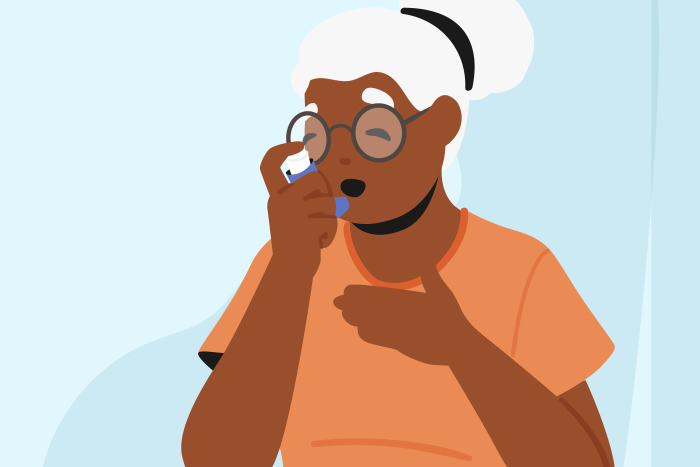Asthma Management With Medicine
If you have asthma, you know how important it is to breathe easily. But managing asthma doesn’t just mean using an inhaler when things get bad. It means staying ahead of symptoms before they start. The good news is, with the right medicine and a simple routine, you can stay in control and enjoy daily life with fewer interruptions.
This article will explain the two main types of asthma medicine, how to use them correctly, and how to build habits that keep your lungs healthy.
Two Types of Asthma Medicines
Asthma medications come in two main types: quick-relief medicines and daily, long-term control medicines. Think of them as your “rescue” and your “protection.”
Quick-Relief Medicine (Rescue Inhalers)
These medicines act fast. You use them when you’re having asthma symptoms—like wheezing, shortness of breath, or chest tightness. They relax the muscles around your airways so you can breathe easier within minutes.
Common rescue inhalers include:
Albuterol (brand names: ProAir HFA, Ventolin HFA, Proventil HFA)
Levalbuterol (brand name: Xopenex)
These inhalers are important to carry with you at all times. But if you’re using your rescue inhaler more than twice a week, it may be a sign that your asthma isn’t well controlled, and you may need to adjust your daily treatment.
Daily Control Medicine (Long-Term Control)
These medicines help reduce swelling and mucus in your airways. They don’t work right away, but when used every day, they help prevent symptoms and asthma attacks.
Types of daily control medications include:
Inhaled Corticosteroids: These reduce inflammation in the airways. Common names: Fluticasone (Flovent), Budesonide (Pulmicort), Beclomethasone (Qvar)
Combination Inhalers: These include both a steroid and a long-acting bronchodilator. Common names: Fluticasone/Salmeterol (Advair), Budesonide/Formoterol (Symbicort)
Leukotriene Modifiers: Taken as pills, these help prevent airway swelling. Example: Montelukast (Singulair)
Theophylline: An older medicine taken by mouth that helps open airways. It's used less often today but may still be helpful for some people.
Your doctor will help decide which type is best based on your symptoms, other health conditions, and how well you respond to treatment.
How to Use Your Inhaler Correctly
Using your inhaler the right way is just as important as having the right medicine. If the medicine doesn’t get into your lungs, it can’t help you.
Here are some tips:
Use a spacer with your inhaler. A spacer is a small tube that your inhaler connects to that helps deliver the medicine into your lungs more effectively, especially if hand strength or coordination is a concern.
Shake the inhaler before each puff (if required).
Breathe out fully before using the inhaler, then aim it toward the back of your throat. Breathe in slowly as you press the inhaler. Hold your breath for a few seconds after inhaling.
Rinse your mouth after using a steroid inhaler to prevent mouth sores or infections.
Ask your doctor or pharmacist to watch you use your inhaler to make sure your technique is right. It can make a big difference.
Build a Simple Routine That Works
It can be easy to forget to take your control medicine every day—especially when you’re feeling fine. But sticking to your daily asthma plan helps so you don’t need your rescue medicines as often to treat flare-ups. Here are a few ways to build healthy habits:
Pair your inhaler with another daily activity, like brushing your teeth or taking other medications.
Use a pillbox or alarm to remind you when it’s time to take your medicine.
Keep a symptom diary or use an asthma app to track when you have symptoms or need your rescue inhaler.
Post your asthma action plan somewhere easy to see, like on the fridge.
Talk with your doctor regularly to review how your medications are working and update your plan if needed.
Know When to Call the Doctor
Even with daily treatment, asthma symptoms can flare up. Call your doctor if:
You’re using your rescue inhaler more than two days a week
Your symptoms wake you up at night
You notice you’re coughing or wheezing more than usual
You can’t do your usual activities without shortness of breath
These are signs that your asthma may not be under control. Don’t wait for a full-blown attack—early action can help avoid emergencies. Having a medical alert device can also give you quick access to help if your symptoms worsen suddenly.*
Breathe Easier with the Right Routine
Managing asthma with medications doesn’t have to be overwhelming. Once you understand what each medicine does—and how to use it correctly—you’ll feel more in control. With the right routine, you can keep symptoms away, avoid serious flare-ups, and breathe easier every day.
If you have questions about your medicines or are having trouble remembering to take them, talk to your doctor or pharmacist. A little support can go a long way in helping you live well with asthma.
Sources:
Centers for Disease Control & Prevention: About Asthma
Mayo Clinic: Asthma
American Lung Association: Learn About Asthma
*Disclaimer: Healthcare Select may earn a commission if you purchase a product or service through links to our partners. This comes at no extra cost to you.

